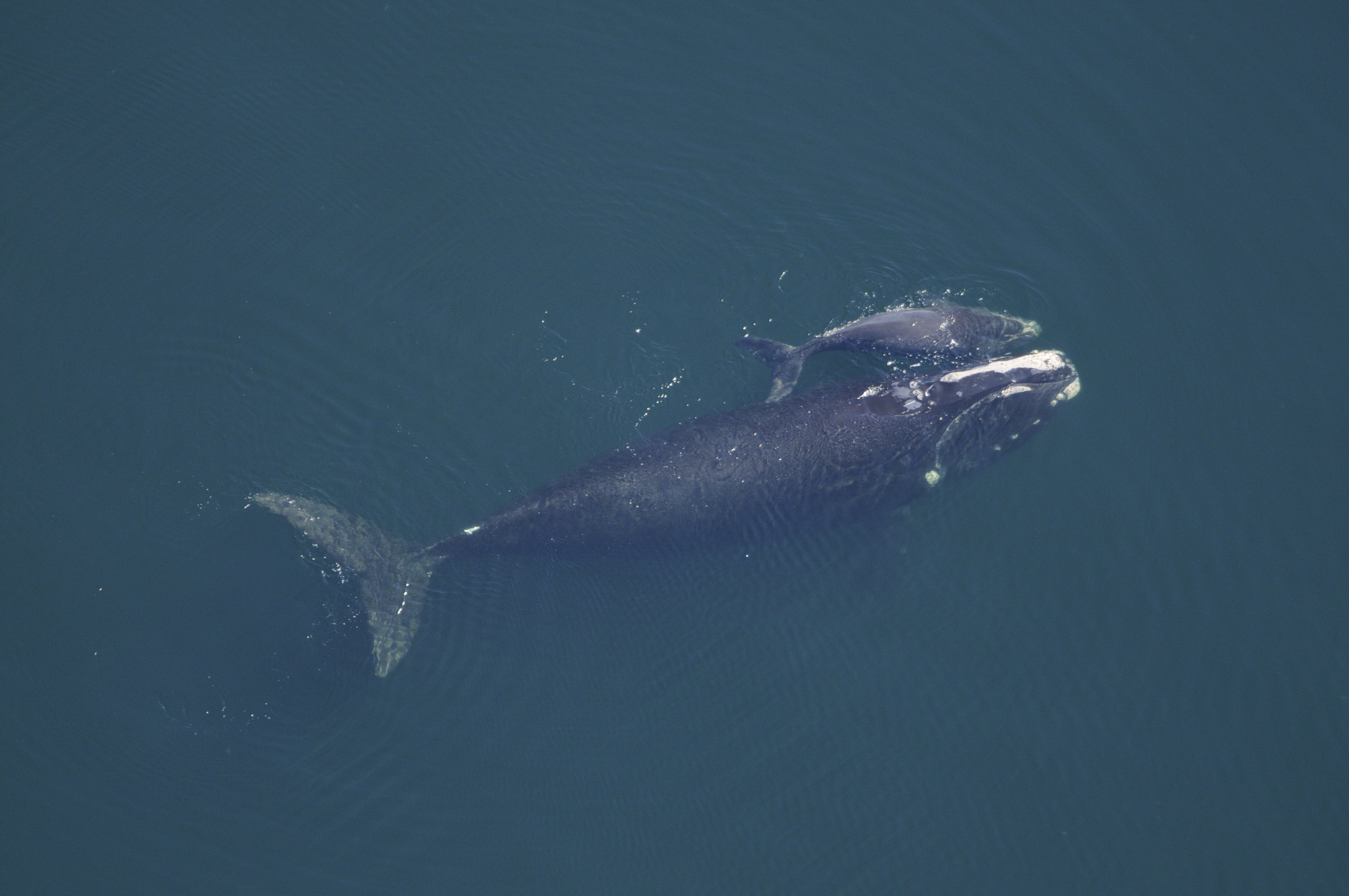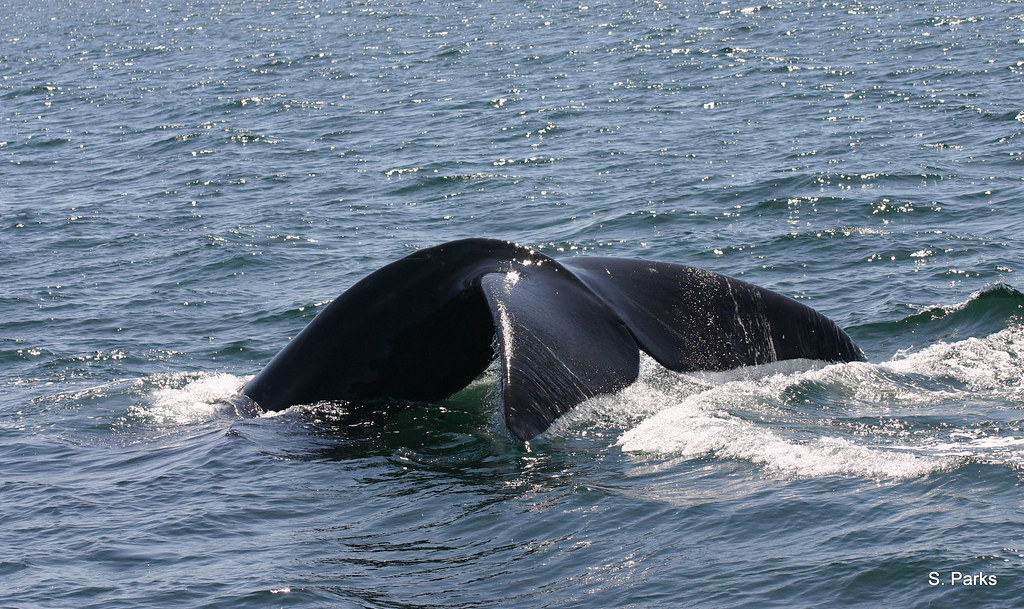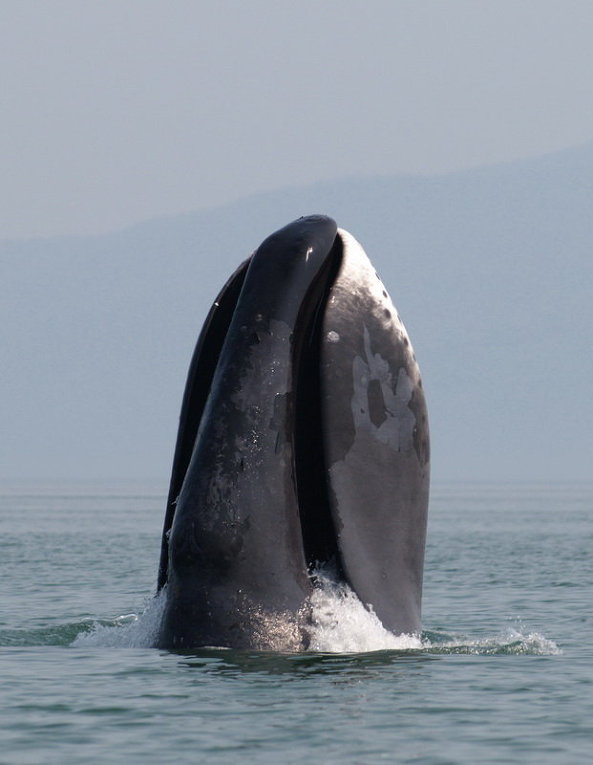Parks SE, Cusano DA, Van Parijs SM, Nowacek DP. 2019 Acoustic crypsis in communication by North Atlantic right whale mother–calf pairs on the calving grounds. Biology Letters. 15: 20190485. http://dx.doi.org/10.1098/rsbl.2019.0485
When a paper is published in a scientific journal, there’s a story you see laid out in structured sections alongside carefully crafted figures, and then there’s the story of the research that doesn’t make it onto the clean pages of the journal. There are complexities and nuances of doing science research, particularly endangered species research, that are often hidden. I had the chance to sit down with my research advisor, Dr. Susan Parks, to ask her about her most recent paper. The paper, published in the journal Biology Letters last week, describes the calls North Atlantic right whale mothers use to communicate with their calves. But what you don’t see as clearly are the challenges behind collecting the data.

New quiet calls
North Atlantic right whales produce a variety of calls which have been recorded from males and females of all ages. But while listening to the calls from mother/calf pairs in the Southeastern US, Dr. Parks and her colleagues noticed something odd. It makes a lot of sense that mothers would want to be quieter when they have their vulnerable calf alongside them, and the researchers did find that mothers make quiet calls 90% of the time. But instead of producing those same calls that have been recorded across the right whale population, the quiet calls made by right whale mothers are entirely new call types.
An example of an upcall from a North Atlantic right whale. Upcalls are produced by males and females of a variety of ages. (Sound from Parks et al. 2019)
“As a biologist and studying behavioral ecology, I found this result really surprising and interesting,” Dr. Parks told me. “What we had expected was just that they would not make any sounds, or if they did, they would make the normal sounds more quietly. But, I think this is the uninformed human making assumptions about an animal system without really thinking through the central complexity.”
Dr. Parks found herself thinking about this complexity by relating it to her own experiences as a mother. “When I had a child,” she explained, “the sounds that I made to my son when he was born were not part of my normal repertoire, but they were still necessary, or I felt they were still necessary for soothing or communicating to my son. And so I think that in hindsight, we probably shouldn’t be surprised that there might be a different set of sounds that are produced by a female mammal when she has offspring.”
An example of one of the new quiet calls recorded from a mother North Atlantic right whale with her calf (Parks et al. 2019)
The challenges of endangered species research
This result on its own is an exciting one to think about as we try to understand how animals communicate. But what about the story that doesn’t make into the journal article? Take the number of tags the researchers were able to deploy on whales, for example. The information regarding the sounds these whales make to communicate is obtained through suction cup tags stuck on the back of a whale using a really long pole. These tags, once on the whale, track the movement of the whales and include an underwater microphone to record the sounds, up until the tag pops off.
This paper describes data recorded on 16 whales, but not all at once: the field work was done in 2006, 2016, and 2017. The paper wasn’t submitted until this year, which isn’t all that surprising given the long process of peer-review and scientific publishing. What is surprising is that the team tried to collect more data in 2018 and 2019 and were unable to. In 2018, there were no calves born across the entire species of North Atlantic right whales, so there were no mother/calf pairs to tag and collect data from. This year, a few calves were born, but none of the researchers or members of various aerial survey teams studying the species were able to find them, making it impossible to collect more data once again.
“So 16 is good enough for pointing out this change that’s really interesting,” Dr. Parks concluded. “But getting the data took a decade of effort and a lot of time in the field by a lot of dedicated people.”

This struggle to collect enough data because of the limited availability of the study subjects highlights what it’s like to study an endangered species. Sometimes you can’t collect the amount of data you might feel is sufficient for the same reason the species continues to decline – there just aren’t enough individuals, and particularly reproductive individuals, in the population.
Dr. Parks told me that one of the things that strikes her most about this paper is that the sound included in the online version of the paper was recorded from a whale named Punctuation, who was named for the comma-shaped markings on her head, and who unfortunately was found dead from a vessel collision just a week before this paper was submitted.
“So that’s been the other tough part about this, is we get to know these individual animals and spend time with them and they’re really awe-inspiring, but a lot of them end up not living very long,” explained Dr. Parks.
This part of the story is really hard to tell, and it’s the part that lies unseen behind the journal article except to those close to the research. Even when the text on the page and the statistical analyses may seem like it, science is never the sterile and un-emotional narrative that it is often presented as. There is a challenging and human saga behind every study. In this case, it’s one of the reasons I admire Dr. Parks and other endangered species researchers so much. It’s their ability to push forward and remain dedicated to the science through all of the hardships faced by both them and the subjects of their studies.
Another example of one of the new quiet calls recorded from a mother North Atlantic right whale with her calf (Parks et al. 2019).
The story of mother/calf communication in right whales is not over yet, nor is it easily concluded. “We don’t know for certain that these quiet sounds are meant to be for communication, or whether they’re some mechanical byproduct of nursing or some other interaction between a mother and a calf,” Dr. Parks explained to me while discussing the new sounds described in the paper. “At this point we’re still just discovering these signals, let alone figuring out why they’re using them.” With so much still unknown about the behavior of these ocean giants, I am excited to see where future studies from these remarkable scientists will lead.
Podcast: Play in new window | Download
I am a PhD candidate at Syracuse University studying marine mammal communication. My research focuses on analyzing underwater recordings of whale calls in order to better understand whale behavior. I’m also interested in education, outreach, and science communication. When I’m not listening to whale sounds, you can find me curled up with a good book or complaining about how much it snows in Syracuse.



